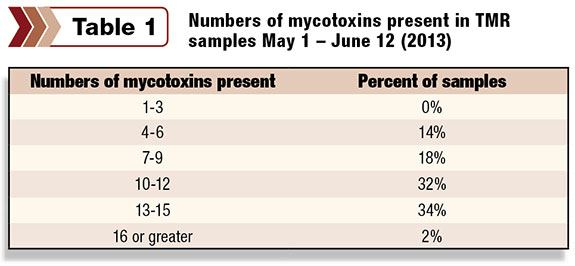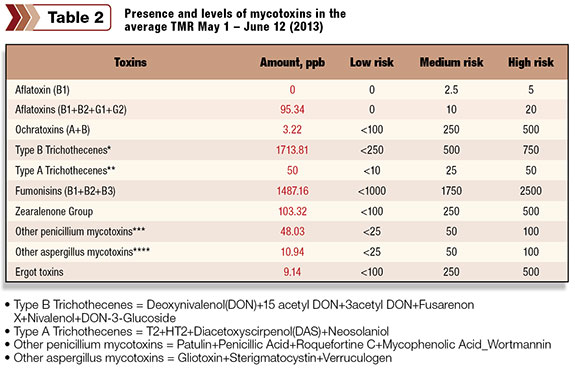The 2012 corn crop started out with early planting and emergence before it took a turn for the worse, tormented by a severe and widespread drought.
Yields suffered, and the environment was just right for molds such as aspergillus and fusarium to prevail. Now, as many dairy producers have found in the first six months of 2013, the 2012 corn crop has created issues in maintaining cow health and performance.
The results of our analysis survey, which included samples from July to December 2012, showed 94 percent of all samples contained between two to 10 mycotoxins.
In corn grain samples, 95 percent contained fumonisin and 48 percent contained DON. In corn silage, 90 percent contained fumonisin and 84 percent contained DON.
Dried distillers grain samples were 100 percent contaminated with both mycotoxins. Although the levels of these toxins were not always at high risk, they will work additively to impact health and performance.
The analysis conducted on silages from August until early May has shown an increase in the number of mycotoxins present.
This confirms the 2012 forage crop has not stored well due to a number of factors such as poor fermentation, inadequate packing, inadequate face management or molds brought in from the fields.
This impacts dairy producers with challenges such as maintaining milk production and cow health as they move further into 2013.
Mycotoxin management programs emphasize that dairy producers begin to concentrate on the total amount of mycotoxins given to cows on a daily basis and not what is in a particular feed ingredient.

A summary of 50 samples in the analysis ran on total mixed rations (TMRs) submitted from May 1 through June 12, 2013 from all regions of the U.S. show the following results (see Table 1 ).
The average number of mycotoxins present is 10 with 68 percent of the TMR samples containing 10 or more mycotoxins.
Multiple mycotoxins can pose a threat due to their ability to work in either an additive or synergistic manner.
Additive is merely a summation of toxicity, but mycotoxins that act synergistically will magnify the effects of other mycotoxins and therefore magnify the negative impact on cow performance and health.

The mycotoxins present and their levels in the average sample in the TMRs analyzed from May 1 to June 12 are shown in Table 2 .
Looking at the total amount of mycotoxins present gives a much more accurate picture of the challenge to the cows, rather than just looking at the analysis of one or two mycotoxins.
The average sample contains high risk threats of total aflatoxins, Type B trichothecenes and Type A trichothecenes.
Individually, these toxins pose a threat, but together they pose a serious challenge to cow health and performance.
Symptoms may be decreased dry matter intake, lower milk production, diarrhea, gut hemorrhage, lower reproductive efficiency or abortion and higher incidence of secondary infections.
Penicillium toxins can create more challenges by impacting rumen function. When considering the total mycotoxins present, you now have a high risk threat to cow health, performance and immune status.
Some producers may not consider that these high risk levels can cause a “crash” in production, but these levels can result in severe drops in milk production, reproduction and cow health over time.
Therefore, the 2012 corn crop issues are not improving and are in fact worsening in terms of challenges to cow health and performance and mycotoxin management.
Mycotoxin management programs encourage the use of mycotoxin analysis to get a broader picture of the total mycotoxin challenge.
Then producers need to implement a mycotoxin control program to reduce the threat to cow health and performance.
In terms of 2013 crop outlook, weather – dry in the Southwest and wet in the Upper Midwest – is already having an effect. The crop was generally planted later, and this can create conditions where the crop will experience more stress later in the growing season.
There was a lot of “trash” or crop residue on top of the ground during a cold, wet spring. This created an ideal growth medium and climate for many fusarium molds to get a foothold.
This is the time is to be proactive. Be proactive with a mycotoxin management program to monitor and finish out the 2012 crop and be vigilant with the status of the 2013 crop as we approach harvest. PD
Hawkins holds a Ph.D. in animal science from the University of Tennessee and currently serves as a nutritionist on the Alltech Mycotoxin Management Team.

-
Max Hawkins
- Nutritionist
- Alltech
- Email Max Hawkins





